#early catholic chapel interior
Text
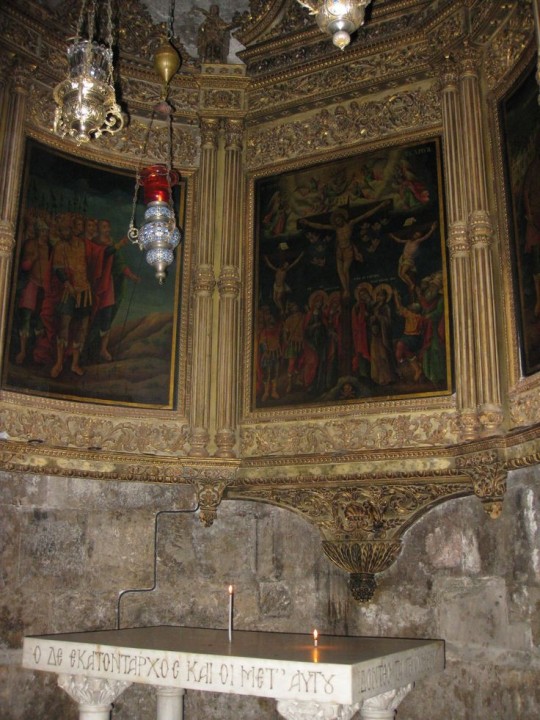
An early Catholic chapel dedicated to St. Longinus. Location unknown.
#traditional catholicism#traditional catholic images#the early catholic church#early catholic chapel interior#traditional catholic saints#st. longinus
5 notes
·
View notes
Text
Vatican City, the smallest independent state in the world, is a place of wonder and beauty. Nestled within the city of Rome, Italy, Vatican City is home to some of the most stunning natural wonders in the world.
One of the most iconic natural wonders in Vatican City is the Vatican Gardens. Covering over 57 acres, these lush gardens are a peaceful oasis in the heart of the bustling city. Filled with vibrant flowers, towering trees, and serene fountains, the Vatican Gardens are a true paradise for nature lovers. Visitors can wander through the winding paths, taking in the sights and sounds of this tranquil retreat.
Another natural wonder in Vatican City is St. Peter's Square. This grand plaza is surrounded by stunning architecture, including the famous St. Peter's Basilica. The square is adorned with beautiful statues and fountains, creating a picturesque setting for visitors to enjoy. St. Peter's Square is also home to the famous Papal Audience, where the Pope addresses the crowds from his balcony overlooking the square.
The Tiber River, which flows through Rome, also adds to the natural beauty of Vatican City. The river is a popular spot for boat tours, offering visitors a unique perspective of the city and its surroundings. The Tiber River is lined with charming cafes and restaurants, making it a great place to relax and enjoy the scenery.
Vatican City is also home to a number of stunning parks and green spaces. The Villa Doria Pamphili, one of the largest parks in Rome, is located just a short distance from Vatican City. This sprawling park is filled with lush greenery, winding paths, and beautiful fountains, making it a popular spot for locals and tourists alike.
In addition to its natural wonders, Vatican City is also home to a number of cultural attractions. The Vatican Museums, which house one of the largest art collections in the world, are a must-see for art lovers. The museums are home to works by some of the most famous artists in history, including Michelangelo, Raphael, and Leonardo da Vinci.
The Sistine Chapel, located within the Vatican Museums, is another must-see attraction in Vatican City. This iconic chapel is famous for its stunning frescoes, including Michelangelo's masterpiece, the Creation of Adam. The chapel is a place of great beauty and significance, attracting visitors from around the world.
Vatican City is also home to the Vatican Library, one of the oldest and most important libraries in the world. The library houses a vast collection of rare books and manuscripts, including some of the oldest known copies of the Bible. Visitors can explore the library's impressive collection, gaining insight into the history and culture of the Catholic Church.
In addition to its cultural attractions, Vatican City is also a place of great spiritual significance. The city is home to St. Peter's Basilica, one of the most important churches in the Catholic faith. The basilica is a stunning example of Renaissance architecture, with its grand dome and intricate mosaics. Visitors can explore the basilica's interior, marveling at its beauty and grandeur.
Vatican City is also home to the Vatican Necropolis, an ancient burial ground located beneath St. Peter's Basilica. The necropolis is believed to be the final resting place of St. Peter, one of the twelve apostles of Jesus Christ. Visitors can explore the necropolis, gaining insight into the early history of the Catholic Church.
Overall, Vatican City is a place of wonder and beauty, with its stunning natural wonders, cultural attractions, and spiritual significance. Whether you're a nature lover, art enthusiast, or history buff, Vatican City has something to offer everyone. So, if you're planning a trip to Rome, be sure to include a visit to Vatican City on your itinerary. You won't be disappointed!
0 notes
Text
Exploring the Spiritual Tapestry: Santa Cruz Churches
Santa Cruz, a coastal gem nestled in California, is renowned for its breathtaking landscapes, vibrant culture, and a rich tapestry of history. Amidst the towering redwoods and the rhythmic waves of the Pacific Ocean, Santa Cruz Churches harbors a profound spiritual essence, embodied by its diverse array of churches. These sanctuaries not only serve as places of worship but also stand as architectural and historical landmarks, weaving a narrative of faith and community.
One of the notable churches in Santa Cruz is the Holy Cross Catholic Church, a striking structure that has graced the cityscape since the late 19th century. Its Gothic Revival architecture, adorned with intricate details and towering spires, draws both the faithful and curious visitors. The church's interior, with its awe-inspiring stained glass windows and reverent ambiance, provides a haven for reflection and prayer. As a cornerstone of the community, Holy Cross Catholic Church not only nurtures the spiritual needs of its parishioners but also actively engages in various outreach programs, exemplifying the essence of faith in action.
For those seeking a more contemporary worship experience, Twin Lakes Church offers a refreshing perspective. With its modern design and welcoming atmosphere, Twin Lakes Church has become a hub for a diverse congregation. The church's commitment to fostering a sense of community is evident in its numerous events and programs, catering to people of all ages and walks of life. Beyond its religious services, Twin Lakes Church serves as a community center, hosting concerts, workshops, and outreach initiatives that aim to make a positive impact beyond its walls.
Venturing into the heart of downtown Santa Cruz, one encounters the Peace United Church of Christ, a beacon of inclusivity and social justice. With a rich history rooted in the early 20th century, this church has evolved into a progressive and affirming community. The iconic sanctuary, with its distinct mid-century modern architecture, is a testament to the church's commitment to embracing diversity and promoting social equality. Peace United Church of Christ actively participates in local advocacy, addressing issues such as homelessness, environmental concerns, and human rights, reflecting the congregation's dedication to living out their faith through meaningful action.
A hidden gem within the spiritual landscape of Santa Cruz the Abbey is the Shrine of St. Joseph of the Mountains. Nestled in the serene Santa Cruz Mountains, this intimate chapel offers a retreat-like experience for those seeking solace and contemplation. The breathtaking views surrounding the shrine create a tranquil setting for spiritual reflection, making it a destination for those in search of a peaceful connection with their faith.
0 notes
Text
Our travel to the Vatican was an incredible and unforgettable experience. The Vatican is the smallest country in the world and is located within the city of Rome, Italy. As the home of the Pope and the center of the Catholic Church, the Vatican is a place of great historical and cultural significance.
We arrived in Rome early in the morning and made my way to the Vatican. The city is beautiful, with ancient Roman ruins and stunning Baroque architecture at every turn. As we walked through the narrow streets, we could feel the rich history of the city all around us.
Upon arriving at the Vatican, we were struck by the grandeur of St. Peter's Basilica, the largest church in the world. The facade of the basilica is adorned with statues and sculptures, and the interior is equally impressive, with its ornate decorations and Michelangelo's famous fresco, "The Last Judgment."
After visiting the basilica, we toured the Vatican Museums, which house one of the largest and most important art collections in the world. We marveled at the beautiful frescoes, paintings, and sculptures on display, including works by artists such as Raphael and Michelangelo.
One of the highlights of our visit was seeing the Sistine Chapel, which is famous for Michelangelo's breathtaking frescoes on the ceiling and altar wall. The detail and beauty of Michelangelo's work is truly breathtaking, and it was an honor to be able to see it in person.

In addition to the art and architecture, the Vatican is also home to the Vatican Gardens, a beautiful and peaceful oasis within the city. We enjoyed a leisurely stroll through the gardens, taking in the sights and sounds of the natural surroundings.
Overall, our travel to the Vatican was a truly memorable experience. From the stunning art and architecture to the rich history and cultural significance of the city, there was so much to see and do. We were grateful to have had the opportunity to visit such an amazing place and am already planning our next trip back.
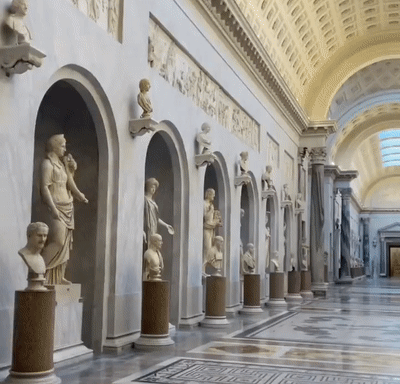
0 notes
Photo

The imposing Baroque architecture features beautifully on the façade of the parish church dedicated to St. Nicholas of Bari in Siġġiewi, Malta. Il-knisja parrokkjali tas-Siġġiewi iddedikata lil San Nikola. This photo was taken on the feast day of 2022 held on June 26th. The present Roman Catholic parish church of Siġġiewi was built at the end of the large St. Nicholas Square, erected by the hardworking villagers who raised the necessary funds for its construction. The church faces a large stone statue of the patron saint of the locality. Work on the church commenced in 1676 and was complete by 1693, although some major modifications took place in the 19th century. It was dedicated to St. Nicholas on 10 May 1729. This church took over the function of an older parish church which was located elsewhere in the village and which now lies in ruins. The chapels of St. Mary and of St. John stand on opposite sides of St. Nicholas Square. ARCHITECTURE The parish church is based on plans made by the famous Maltese architect Lorenzo Gafà. In 1862 it was enlarged according to plans drawn up by Dr. Nikol Zammit. The side aisles, dome and portico were added. INTERIOR & WORKS OF ART The titular painting is Mattia Preti's work. Preti, known as 'Il calabrese', was also responsible for the painting on the vault of St. John's Co-Cathedral in Valletta. The wooden statue which is carried in procession in the city’s feast day was sculptured by Pietro Felici in 1736. Fours years earlier, in 1732, the same sculptor had produced the stone statue which still stands in the centre of the square. On its pedestal there is a prayer in Latin which implores the saint to bless the fields which the faithful laboriously till. Other paintings housed inside the church include works of Francesco Zahra, Matteo Perez d'Aleccio, Erardi and Giuseppe Bonnici. THE ORIGINAL PARISH CHURCH Siġġiewi was listed as one of Malta's first parishes by Bishop Senatore de Mello in his rollo of 1436. The old parish church was located in another part of the village, and it was built and enlarged gradually between the 15th and early 17th centuries. (at Siggiewi) https://www.instagram.com/p/CfResTJISp9/?igshid=NGJjMDIxMWI=
0 notes
Text

Say You Won’t Let Go
a Sidney Crosby wedding series
Part Two
a/n: here’s part deux! read part one here. this will have at least one more part, probably 2! worth noting that I know next to no French and am relying heavilyyyy on our pal Google Translate in this story.
summary: a little more background throughout, as Juliette and Sidney meet up with their families and hockey star-studded bridal party for a rehearsal at their iconic wedding venue. if you’re not familiar with the location (it’s honestly incredible), click here for a look!
warnings: mention of deceased father. otherwise, so damn fluffy it’s practically cotton candy.
_____
Sidney and I arrived at the church exactly on time, much to Lauren’s satisfaction, with two cars carrying Mario’s crew pulling in at the next moment. I closed the passenger door of Sidney’s steel grey Range Rover and turned to take in the sight of our wedding venue, Heinz Chapel on Pitt’s campus, reaching a hand up to shield my face from the early evening sun as I gazed. Sidney did the same, coming to stand next to me and snaking an arm around my torso.
“Not a bad place to get married, eh?” he teased, kissing the crown of my head. I smiled and shook my head. “I’ve dreamed of this since the moment I first saw this place,” I told him. “It’s perfect.”
He took a step forward, offered his hand to me and grinned, quite pleased that we had been able to reserve the coveted location last summer despite it typically being booked three or more years in advance. I didn’t often request many special favors in the name of my uncle or fiancé, but this was one that seemed a necessity. Taking Sidney’s hand and walking toward the cathedral-style landmark, I said a silent prayer of thanks that I’d gotten even more than what I always dreamed of, in so many ways.
My family and Sidney walked into the chapel to find his parents and our bridal party already mingling near the pews, excitement palpably buzzing beneath the magnificent arches and towering stained-glass windows that decorated the exquisite interior. As we stepped through the doors, they turned our way, and I let out an echoing, very French-Canadian-sounding, “Allooo!” making them all laugh.
I first greeted Troy, Trina, and Taylor with hugs and warm hellos. Sidney’s parents were staying at his former townhome on Mt. Washington, which previously served as his bachelor pad and now housed Taylor in light of her recent move to Pittsburgh. We had spent much quality time with the elder Crosbys since their arrival from Nova Scotia a few days ago, helping us with final preparations and enjoying each other’s company ahead of my official entrance into their family.
Both Trina and Nathalie had accompanied me earlier in the week to my final dress fitting and pickup appointment at the bridal boutique where I had selected my gown. Though my mother did plan to attend the wedding ceremony as a guest, she was uninterested in playing the traditional mother of the bride role and joining me for such commitments, which hadn’t surprised me but still stung sharply, especially when I was fastened into the gown and presented by the salon attendant to a waiting Trina and Nathalie.
Bitter tears pricked my eyes as I allowed myself to feel robbed of sharing that moment with my own mom. My sadness was quickly overcome, however, when the women, sensing my sadness, warmly embraced me and fawned over me, admiring the perfect fit of the gown, both becoming emotional when Nathalie tucked my headpiece and veil tenderly into my hair.
The three of us stared at my reflection in the mirror for a few moments as we let tears of many complicated emotions fall, with joy prevailing above them all. I couldn’t keep the enormous smile from my cheeks when Trina squeezed my shoulder and whispered, “Oh, sweetheart, just wait until Sidney sees you.”
Now, we were less than 24 hours away from that moment, with our bridal party and family bustling around us in the chapel.
As our officiant, Father Antonio, announced that we would be lining up for the rehearsal momentarily, Lauren approached me with a grin, extending a bouquet she had made of the countless ribbons and bows from my bridal shower gifts acquired a couple of months ago. I giggled at how cheesy yet adorable the arrangement looked, thanking her as we huddled at the back of the aisle with my bridesmaids and Sidney’s groomsmen.
“This place is a little beat up,” Nate MacKinnon, our best man, ribbed Sidney from between the two of us. “I don’t know why you guys picked this dump,” he added, pulling me to his side. Sidney shoved lightly at his chest before the two of them laughed and embraced.
“Yeah, the old barn in Cole Harbour was booked this weekend, so we kinda had to settle for the next best thing,” Sidney played into Nate’s teasing, as his longtime best friend Mike, also a Cole Harbour native, approached us.
“Kind of a shithole,” Nate whispered, earning a warning glance from me as Austin tried to hold in hysterical laughter. “You can’t say shit in church!” Austin forced out from under his breath. “Oh, we’re going straight to hell,” Mike commented softly. Sidney gave me an apologetic look and I smiled up at him.
“It’s fine. These are our people!” I said to him, flicking Nate’s elbow as I passed him. “Besides, we’ve already been living in sin,” I added, winking at Sidney. He gave me a look of mock disbelief and insisted, “No. I don’t know what you’re talking about. I’m a nice Catholic boy.” I giggled and pushed onto my tiptoes to kiss his cheek, which smelled of his fresh aftershave.
In addition to Nate, Mike, and Austin, we greeted Sidney’s other groomsmen as we prepared for the rehearsal — his current teammates Kris Letang and Evgeni Malkin and former Penguin Marc-Andre Fleury. They had all graciously accepted the invitation by Sidney to play this special role in our day, with Geno flying in from Russia and Kris and Marc-Andre from Quebec.
Marc-Andre had brought a few other important components to our day along with him — not the least of which was his wife and my best friend, Veronique. She and I had first met when Sidney and I were only casually seeing each other, and she had predicted this wedding long, long ago. She had been one of our biggest cheerleaders since the day we met, and despite her and Marc’s eventual move to Las Vegas, the four of us remained the closest of friends, visiting each other when the men’s respective teams played and whenever else possible.
With Lauren as my maid of honor and Stephanie, Alexa, and Taylor as three of my other bridesmaids, my friend Jacqueline, a Pittsburgh transplant with Canadian roots whom I met while studying at Duquesne, rounded out my crew of six ladies who would stand by my side on this long-awaited day.
To up the cuteness factor, Sidney and I had selected Marc-Andre and Veronique’s daughters, Estelle and Scarlet, as our flower girls, with Geno’s son Nikita and Kris’s son Alex as our ringbearers. Nikita was still a bit young to understand his role, but grinned broadly when Sidney told him when they arrived just how important he was to our day. On the other hand, Kris told us that Alex had cried after his parents had asked him to be in our wedding, because, as much as he adored and was attached to Sid, Alex had been under the impression that I was his girlfriend, not Uncle Sidney’s.
Eventually, after Sidney and I made the rounds to greet them all, the entire bridal party was grouped together to begin the walk-through. The venue’s wedding planner wrangled the children as the priest noted that Sidney needed to leave my side to approach the front of the church alone, in preparation for his emergence from one of the side doors at the front of the sanctuary tomorrow.
Playful “oooh”’s erupted from our groomsmen, who teased Sid about having to pry himself away from my hip. Sidney rolled his eyes, nodding and smirking, before turning his full attention to me. He tucked some hair behind both of my ears before caressing my cheeks with his thumbs.
“You gonna be okay, Jules?” Sidney asked, eyes wider than normal as he searched mine carefully.
I knew he wasn’t asking if I would be alright once he left my side to stand twenty yards away for the next five minutes, but rather if I would be able to contain my emotions as Mario walked me down the aisle, even during a practice run, in place of my father.
We had talked about this specific part of our day a number of times, with Sidney even pondering aloud whether he should walk me down the aisle himself because walking with anyone except my dad felt impossible to me. His sweet dad had even offered to do so, should I desire. After each conversation, Sidney and I both kept arriving at the same conclusion — that the best and most appropriate plan of action was for Mario to give me away and also to join me for the traditional father-daughter dance at the reception.
I nodded, holding onto Sidney’s wrists. “Yeah,” I whispered. “I’ll be okay,” I promised. He nodded solemnly in return and kissed my forehead before pulling back with a wink.
“You can do this,” he encouraged. “I’ll see you up there.” I gave him my best smile as he turned and walked to the front of the chapel.
As our wedding party lined up in front of me to take their positions, Nate stopped me for one of his signature bear hugs, resting his chin on top of my head just for a moment before releasing me. The rest of our group squeezed my hands and rubbed my arms lovingly as I walked to the back door of the sanctuary where Mario waited, hands folded in front of his hips and a tentative smile on his features. He, too, gave me a sweet kiss on the forehead before holding my shoulders at arm’s length.
“Listen, princesse, it was one of the greatest honors of my life when you asked me to walk you down the aisle,” Mario said, soft enough that only I could hear. “But if you’ve changed your mind and would rather do this some other way, please, just say the word.” I shook my head and wrapped my arms around his waist just as the piano music began.
“No, you are exactly the person my dad would want doing this if he couldn’t,” I told him confidently. Mario let out a small exhale, and I could tell he was trying to remain composed. As we parted, he said, “Then let’s go make him proud.” He offered his arm to me and I wrapped my hands around it firmly, leaning my head into his shoulder briefly.
We watched pairs of our party head down the aisle toward Sidney and the priest at a relaxed pace: Jacqueline and Geno led off, followed by Veronique and Marc-Andre, Taylor and Kris, Alexa and Austin, Stephanie and Mike, and finally, Lauren and Nate. Alex walked down the aisle in a near-skip, holding a fake pillow very carefully just as his mother, our beautiful friend Catherine, had instructed him, with Nikita by his side mimicking his every move. Their fathers gave them thumbs up and everyone clapped lightly when they reached the end of the aisle.
Next, after a bit of prompting from both their parents at the front, Estelle and Scarlett followed the boys’ path, scattering fake rose petals in place of the real ones they would have tomorrow, earning their own quiet round of applause. As the children were seated at the ends of the front pews on either side, the music shifted, and our wedding planner turned and gave Mario and me the nod.
“Ready, Juliette?” he asked softly. My eyes traveled down the long red carpet in front of us to the steps where the love of my life stood centered in between our closest friends and family, waiting for me. He gave me a warm, adoring smile and at that moment, I felt my unease melt away, just as it always did when Sidney was near.
“I’m so ready,” I whispered.
#sidney crosby#crosby#sidney crosby fic#sidney crosby fanfiction#sidney crosby fanfic#sidney crosby writing#sidney crosby imagine#hockey#hockeyblr#hockey fanfiction#hockey fanfic#hockey fic#hockey writing#hockey imagine#hockey fluff#nhl#nhl hockey#nhl writing#nhl fanfiction#nhl fanfic#nhl fic#nhl imagine#nhl fluff#nhl hockey writing#mario lemieux#mario#Lemieux#pittsburgh penguins#penguins hockey#say you won’t let go x sidney crosby
64 notes
·
View notes
Photo

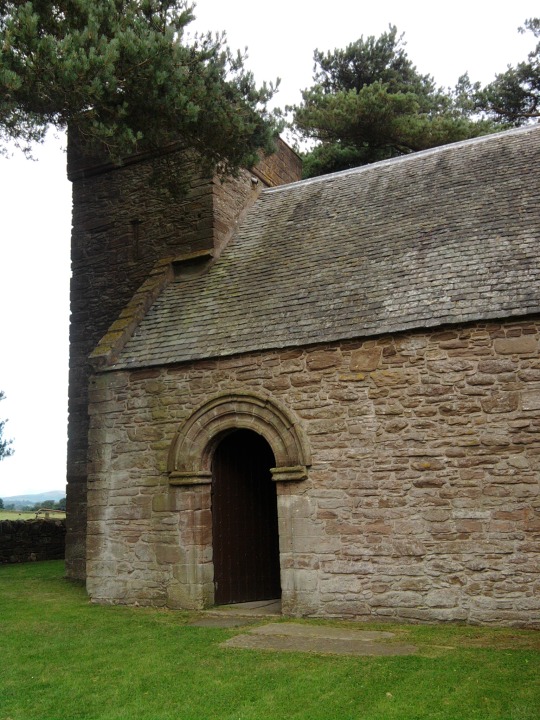

Places to Go: Tullibardine Chapel
A small kirk sheltered by Scots pines, Tullibardine Chapel has an air of tranquility and simple elegance. Formerly the private chapel of the Murrays of Tullibardine, it is one of the few buildings of its kind in Scotland to have survived with many of its medieval details intact.
The Murrays acquired the lands of Tullibardine in the late thirteenth century, when William ‘de Moravia’ married a daughter of the steward of Strathearn. Later, through judicious marriages and court connections, they first became earls of Tullibardine and then Dukes of Atholl. But even as lairds the Murrays were a significant power in late mediaeval Perthshire. In those days Tullibardine Castle was one of their main strongholds, and the close proximity of royal residences like Stirling meant that the Castle also hosted several notable guests. Mary, Queen of Scots, stayed there in December of 1566 (allegedly in the company of the earl of Bothwell). One laird of Tullibardine became Master of Household to the young James VI, while his aunt Annabella Murray, Countess of Mar, oversaw the king’s upbringing. Thus James VI was also a frequent visitor and it was he who created the earldom of Tullibardine in 1606. The king is known to have attended the wedding of the laird of Tullibardine’s daughter Lilias Murray, though it is unclear whether this took place at Tullibardine itself. The castle grounds were probably an impressive sight too: the sixteenth century writer Robert Lindsay of Pitscottie claimed that a group of hawthorns at the “zeit of Tilliebairne”* had been planted in the shape of the Great Michael by some of the wrights who worked on the famous ship.
Thus the tower at Tullibardine, though presumably on a small-scale, was apparently comfortable and imposing enough for the lairds to host royalty and fashion an impressive self-image. But the spiritual needs of a late mediaeval noble family were just as important as their political prestige, and a chapel could both shape the family’s public image and secure their private wellbeing. The current chapel at Tullibardine, which originally stood at a small distance from the castle, was allegedly founded by David Murray in 1446, “in honour of our blessed Saviour”. At least this was the story according to the eighteenth century writer John Spottiswoode, and his assertion is partly supported by the chapel’s internal evidence, though no surviving contemporary document explicitly confirms the tale. A chapel certainly existed by 1455, when a charter in favour of David’s son William Murray of Tullibardine mentions it as an existing structure. In this charter, King James II stated that his “familiar shieldbearer” William Murray has “intended to endow and infeft certain chaplains in the chapel of Tullibardine”. Since the earls of Strathearn had previously endowed a chaplain in the kirk of Muthill, but duties pertaining to the chaplaincy had not been undertaken for some time, James transferred the chaplaincy to Tullibardine. He also granted his patronage and gift of the chaplaincy to William Murray and his heirs.
The charter indicates that Tullibardine Chapel was an important project for the Murrays. Interestingly though, no official references to the chapel in the fifteenth, sixteenth, or seventeenth centuries describe Tullibardine chapel as a collegiate church, even though later writers have frequently claimed this. Collegiate foundations were increasingly popular with the Scottish nobility during the late Middle Ages, but, although such a foundation might have been planned for Tullibardine, there is no evidence that this ever took place.
The 1455 charter serves as an early indication of the chapel’s purpose and significance. Judging by its architecture the current chapel does appear to have been constructed in the mid-fifteenth century. However it was also substantially remodelled and enlarged around 1500, when the western tower was added. One remnant of the original design is the late Gothic ‘uncusped’ loop tracery on the windows. Despite the apparent simplicity of the chapel, features such as this window tracery have been taken as evidence that its builder was acutely aware of contemporary European architectural fashions. Another interesting feature is the survival of the chapel’s original timber collarbeam roof, a rare thing in Scotland. Several coats of arms belonging to members of the Murray family adorn the walls and roof corbels, although some of these armorial panels were probably moved when the chapel was reconstructed. They include the arms of the chapel’s alleged founder David Murray and his wife Margaret Colquhoun, as well as those of his parents, another David Murray and Isabel Stewart. A later member of the family, Andrew Murray, married a lady named Margaret Barclay c.1499, around the same time that the chapel was renovated, and although they were buried elsewhere, their coats of arms can also be seen there. Aside from such details- carved in stone and thus less perishable than books and vestments- the chapel’s interior seems quite sparse and bare today. Originally though the mediaeval building probably housed several richly furnished altars and some of the piscinas (hand-washing stations for priests) can still be seen in the walls. But the sumptuous display favoured in even the smallest mediaeval chapels was soon to be swept away entirely by the Reformation of 1560, when Scotland broke with the Catholic Church and Protestantism became the established faith of the realm.
Tullibardine was used chiefly as a private burial place after the Reformation, but there are signs that the transition from one faith to another was not entirely smooth. Four years after the “official” Reformation, a priest named Sir Patrick Fergy was summoned before the “Superintendent” of Fife, Fothriff, and Strathearn to answer the charge that he had taken it upon himself “to prech and minister the sacramentis wythowtyn lawfull admission, and for drawing of the pepill to the chapel of Tulebarne fra thar parroche kyrk”. Fergy did not obey the summons and so it was decided that he should be summoned for a second admonition. It is not known whether Fergy compeared on that occasion, nor what kind of punishment he might have received for his defiance. We are also in the dark as to the laird of Tullibardine’s views on the situation, even though it was going on right under his family’s nose. Nonetheless the case does provide a glimpse into what must have been a complex religious situation in sixteenth century Perthshire, no less for the ordinary parishioner than for the nobility. It also raises the possibility that private worship continued in the chapel after the Reformation, albeit unofficially.
Even as Tullibardine chapel’s public role diminished, the castle was still of some importance. Royal visits must have been considerably rarer after James VI succeeded to the English throne in 1603, and the Murrays of Tullibardine themselves acquired greater titles and estates, but the tower at Tullibardine still witnessed some notable events. During the first half of the eighteenth century, the castle was the home of Lord George Murray, a kinsman of the Duke of Atholl and famous for his participation in the Jacobite Risings of 1715, 1719, and 1745. During the last of these, Tullibardine Castle played host to a Jacobite garrison and was visited by Charles Edward Stuart. In less warlike times, Lord Murray often resided with his family at Tullibardine, and one of his daughters, who sadly died in infancy, seems to have been buried in the chapel. Lord George himself expressed a wish to be buried there as well but he was forced to flee into exile on the continent after the failure of the ’45, and so his body was interred “over the water” at Medemblick, in the Netherlands.
After Lord George’s exile Tullibardine castle entered a period of slow decline. Much of the fabric of the building was removed in 1747. Some years earlier plans had been made for the old tower to be replaced by a fashionable new house designed by William Adam, but these never materialised. A sketch of the mediaeval chapel made in 1789 shows the castle in the background- a roofless, tumbledown ruin. Tullibardine castle was finally demolished in 1833, and the family chapel, whose very existence had for centuries been defined by its proximity to the laird’s house, now stands alone. We are thus all the more fortunate for its survival, and both its attractive situation and interesting mediaeval features make Tullibardine chapel well worth a visit.
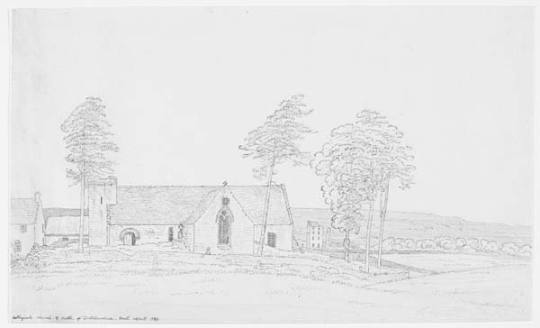
(Tullibardine Chapel, with the castle ruins in the background, as sketched in 1789. Reproduced with permission of the National Libraries of Scotland, under the terms of the Creative Commons Attribution 4.0 License)
Sources and notes may be found under the ‘read more’ button.
* “zeit” is presumaby “yett”, the old Scots word for gate.
Selected Bibliography:
- “Account of All the Religious Houses That Were in Scotland at the Time of the Reformation”, by John Spottiswood, in “An Historical Catalogue of the Scottish Bishops Down to the Year 1688″, by Reverend Robert Keith.
- Seventh Report of the Royal Commission on Historical Manuscripts, Part 2 (Duke of Atholl papers)
- “Register of the Ministers, Elders, and Deacons of the Congregation of St Andrews”, volume 4, Part 1 (St Andrews Kirk Session Register), edited by David Hay Fleming
- “Statement of Significance: Tullibardine Chapel”, Historic Environment Scotland
- “The Historie and Croniclis of Scotland From the Slauchter of King James the First to the Ane Thousande Five Hundreith Thrie Scoir Fiftein Zeir”, by Robert Lindsay of Pitscottie, volume 1 edited Aeneas J. G. Mackay.
- “Late Gothic Architecture in Scotland: Considerations on the Influence of the Low Countries”, by Richard Fawcett in ‘Proceedings of the Society of Antiquaries Scotland’, 112 (1982)
- “Aspects of Timber in Renaissance and Post-Renaissance Scotland: The Case of Stirling Palace”, Thorsten Hanke
- “Register of the Privy Seal of Scotland”, Vol. 5, ed. M. Livingstone
- “The Household and Court of King James VI”, Amy L. Juhala
- “Memoirs of the Affairs of Scotland”, by David Moysie, ed. James Dennistoun for the Bannatyne Club
- “Calendar of State Papers, Scotland”, Volume 10, 1589-93, ed. William K. Boyd and Henry W. Meikle
- “The Indictment of Mary Queen of Scots, as Derived from a Manuscript in the University Library at Cambridge, Hitherto Unpublished”, by George Buchanan, edited by R.H. Mahon
#Scottish history#Scotland#British history#Perthshire#Places to go#Strathearn#Tullibardine Chapel#Tullibardine#Auchterarder#fifteenth century#sixteenth century#eighteenth century#1450s#1500s#building#architecture#Gothic Architecture#kirk and people#religion#Church#Christianity#private chapel#chapel#Murray family#Murrays of Tullibardine#Murray#Duke of Atholl#Jacobites#James VI#Mary Queen of Scots
9 notes
·
View notes
Photo

August 30 - Today is the feast day of Saint Rose of Lima. Ora pro nobis.
Born Isabella de Flores, Saint Rose was the daughter of a Spanish immigrant father and a Peruvian mother. She was personally confirmed by the Archbishop of Lima, Saint Turibiuis de Mongrovejo, and took the name Rose. Her family and friends had been calling her “Rosa,” as when she was still an infant, one of the family’s servants had seen her face miraculously transform into the vision of a mystical Rose. All of Saint Rose's sufferings were offered for the conversion of sinners, and the thought of the multitudes in hell was ever before her soul. She died in 1617, at the age of thirty-one.
by F. M. Capes, 1899
We may not say that St. Rose was the first saint of the New World, for God only knows His own; but she was the first of America's children to be placed in the calendar of canonized saints–the first flower gathered from that part of the great garden over which St. Dominic has been placed as the husbandman of Jesus Christ.
Almost before she was out of her infancy, that love of Our Lord's suffering, which was afterwards to become the ruling passion of her life, began to lay hold of little Rose's heart. How God speaks to the baby souls of those early-chosen children of His special delight; by what channels the Divine secrets are imparted to their barely-opened minds; what marvelous gift enables them to entertain and understand thoughts far beyond their years–we cannot know; but that such special communications are made to some of the Saints even as little children is certain.
In St. Rose's case the working of these mysterious operations in her heart was witnessed to by the fact that, as a little thing barely able to walk, she would often be found, having managed to escape from her guardians or companions, absorbed in deep infantine contemplation before a picture of the thorn-crowned Christ, in His mantle of scorn, which hung in her mother's room.
Her own apprenticeship in her Master's school, too, began early; for from the time that she was three years old Rose de Flores was the subject of one accident or complaint after another, and was kept perpetually in states of suffering which were sharp trials to her childish patience.
This ideal she realized in her life. It is this life of penance and mysticism which is presented to the reader in these pages. Everything in her life calls for admiration, many things for imitation, some, maybe, for explanation. The reader of this record of her ways and works will perforce exclaim: ‘Wonderful is God in His saints'–wonderful in their number, in their graces, in their variety.
St. Rose's life was eminently wonderful in its marvelous penance, its deep, earnest, and all but continuous prayer, its perfect union with God. She studied in the school of Christ; her book was the Cross; her Master the Crucified. Naturally of delicate health, weak in body, and physically feeble, hers was a life of chronic suffering. To this she added much fasting, abstinence, and penances of every kind, as will be seen from the perusal of this interesting and instructive life. But all her sufferings, whether sent by God or self-inflicted, were borne for God, with God, and in God.
She could say with the Apostle: ‘With Christ I am nailed to the Cross; and I live, now not I, but Christ liveth in me. Her suffering life was a life of detachment from the world–a life of union with God. If she could make her own the words of St. Paul, ‘The world is crucified to me, and I to the world, she could add with equal truth, ‘I live in the faith of the Son of God, Who loved me and delivered Himself for me.'
ST. ROSE OF LIMA, VIRGIN
BY FATHER FRANCIS XAVIER WENINGER, 1876
God gave to the Christians of America, and all over the world, a beautiful example of holiness, at the end of the sixteenth and the beginning of the seventeenth century, in the Saint whose festival is this day commemorated by the Catholic Church. Her native place was Lima, the capital of Peru. She was named Isabel, but while yet in the cradle, she was called Rose, as her face, in its loveliness, resembled a rose. She took the surname of St. Mary, by order of the Blessed Virgin. Already in her childhood, her conduct was holy. Her intention was to follow the example of St. Catherine of Sienna, whose life she had read, and therefore she entered the third order of St. Dominic. When five years old, she consecrated her virginity to God, and was such a perfect hand-maiden of the Lord, that during her whole life, she never offended Him by a mortal sin, nor even intentionally by one that was venial. Her time was divided between prayer and work. Twelve hours she gave to devout exercises, two or three to sleep, the rest to work.
When grown to womanhood, her hand was sought by several, but she always unhesitatingly gave the answer, that she was already promised to a heavenly spouse. That, however, her parents might no further urge her, she herself cut off her hair, as a sign of her consecration to God. She treated her innocent body with extreme severity. From her childhood she abstained from fruit, which, in Peru, is so delicious. Her fasts and abstinences were more than human; for, when scarcely six years old, her nourishment consisted almost entirely of water and bread. At the age of fifteen, she made a vow never to eat meat, except when obliged by obedience. Not even when sick did she partake of better food. Sometimes for five or eight days, she ate nothing at all, living only on the bread of angels. During the whole of Lent, she took only five citron seeds, daily. Incredible as this may appear to the reader, it is told by unquestionable authority. Her bed was a rough board, or some knotted logs of wood. Her pillow was a bag filled with rushes or stones.
Every night she scourged her body with two small iron chains, in remembrance of the painful scourging of our Saviour, and for the conversion of sinners. When, however, her Confessor forbade her this, she, after the example of St. Catherine of Sienna, bound, three times around her body, a thin chain, which in a few weeks, had cut so deeply into the flesh that it was scarcely to be seen. Fearing that she would be compelled to reveal it, she prayed to God for help, and the chain became loose of itself. Hardly were the wounds healed, when she again wore the chain, until her Confessor, being informed of it, forbade her to do so, She then had a penitential robe made of horse-hair, which reached below her knees, and occasioned her intense suffering. She wore under her veil, in remembrance of our Saviour's crown of thorns, a crown which was studded inside with pins, and which wounded her head most painfully. To attend the better to her prayers, she loved solitude above everything.
To this end, she asked the permission of her parents to build a small cell for herself in the corner of the garden. This cell was only five feet long and four feet wide; but she lived more happily in it than many others do in royal palaces. O, how many graces she obtained from heaven in this place! How many visions she had there of St. Catherine of Sienna, her Guardian Angel, the Blessed Virgin, and even of Christ Himself! She was also frequently favored with visions in other places. The most remarkable of these was one which she had on Palm Sunday, in the chapel of the Holy Rosary, before an image of the Blessed Virgin. Rose, gazing at the picture, perceived that the Virgin Mother, as well as the divine Child, regarded her most graciously, and at last she heard distinctly from the lips of the divine Child, the words: “Rose, you shall be my spouse.” Although filled with holy awe, she replied, in the words which the Blessed Virgin had spoken to the Angel: ” Behold, I am a handmaid of the Lord, be it done to me according to thy word.” After this, the Virgin Mother said: “May you well appreciate the favor which my Son has accorded to you, dear Rose!”
I leave it to the pious reader to picture to himself the inexpressible joy which this vision gave to Rose. It served her as a most powerful incentive to the practice of all virtues. Among these virtues, surely not the least was the heroic patience which this holy virgin showed, as well in bodily suffering, as in interior, spiritual anguish. The Almighty permitted her, for fifteen years, to be daily tormented, at least, for an hour, by the most hideous imaginations, which were of such a nature, that she sometimes thought that she was in the midst of hell. She could think neither of God nor of the graces He had bestowed upon her; neither did prayer or devout reading give her any comfort. It sometimes seemed as if she had been forsaken by God. In this manner, God wished to prove and purify her virtue, as He had done in regard to many other Saints. Her patience was also most severely tried by painful diseases, as she sometimes had a combination of two or three maladies at the same time, and suffered most intensely.
During the last three years of her life, she was disabled in almost all her limbs; but her resignation to the will of God was too perfect to allow her to utter a word of complaint. All she desired and prayed for was to suffer still more for Christ's sake. She, at the same time, encouraged other sick persons, whom she served with indescribable kindness, as long as she was well. She endeavored to comfort them when it was necessary to prepare them for a happy death; for, her greatest joy was to speak of God and to lead others to Him. One day when she was greatly troubled about her salvation, Christ appeared to her and said: ” My daughter, I condemn those only who will not be saved.” He assured her at the same time, first, that she would go to heaven; secondly, that she never would lose His grace through mortal sin; thirdly, that divine assistance would never fail her in any emergency. God also revealed to her the day and hour of her death, which took place in her thirty-first year. After the holy sacraments had been administered to her, she begged all present to forgive her faults, and exhorted them to love God. The nearer the hour of her death approached, the greater became her joy.
Shortly before her end, she went into an ecstasy, and after it, she said to her Confessor: ” Oh! how much I could tell you of the sweetness of God, and of the blissful heavenly dwelling of the Almighty!” She requested her brother to take away the pillow that had been placed under her head, that she might die on the boards, as Christ had died on the cross. When this was done, she exclaimed three times: “Jesus, Jesus, be with me!” and expired. After death, her face was so beautiful, that all who looked at her were lost in astonishment. Her funeral was most imposing. The Canons first carried the body a part of the way to the church; after them the senate, and finally, the superiors of the different orders, so great was the esteem they all entertained for her holiness. God honored her after her death, by many miracles; and Clement X. canonized her in 1671 and placed her among the number of the holy virgins.
11 notes
·
View notes
Photo
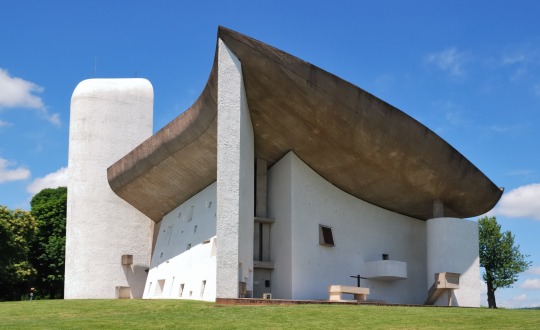


Notre Dame du Haut The Notre Dame du Haut is a Roman Catholic chapel built in 1955 to replace the church before it, which was bombed in WW2. It was designed by Charles-Édouard Jeanneret, more commonly known as Le Corbusier. The function of this chapel is to provide sanctuary to those on pilgrimages and was commissioned by the non-profit Association de l'Œuvre Notre-Dame du Haut. The Chapel is situated in Ronchamp, France, which was a comparatively insignificant town. Commissioning Le Corbusier, an incredibly famous architect to re-build it after the WW2 would imply that it was built as a statement or a symbol, especially since it can be seen from afar as you approach the swiss boarder, due to the fact that its on top of a hill. It has also positively impacted the surrounding community as an estimated 65,000 tourists visit it each year, which would have been extremely beneficial to rebuilding the local economy after the war. The name of the church translates to “Our Lady of Heights”, using the name of the previous Chapel dedicated to the Holy Lady, which was estimated to have been built in the early Middle Ages.
This Roman Catholic chapel is made out of concrete but the walls have a hand-finish which gives it a sense of weightlessness. This enhances the ethereal feel of the church interior as the simplicity has a calming and peaceful effect. The finish on the walls gives the church a sense of purity. The Chapel has a relatively simple design, consisting of only two entrances, one altar and three chapels situated beneath the towers, which contrasts other Catholic churches and chapels which are usually heavily decorated. However, the simplicity doesn’t take away the striking effect that the Chapel has from both the outside and the inside. The sparse interior is connected to the outside via the slightly raised roof and natural light from the many small windows which pierce the darkness. This gives the chapel a natural, almost earthy feel, enhanced by the smooth curves and lack of sharp edges, which could be inspired by the idea that God shows himself through nature, and the connection with nature is like a connection with God. It also gives the interior a mountain cave impression, again connecting us with nature.
The exterior is more sculptural which shows status as creating the moulds for the concrete and engineering involved in the overall structure is a difficult thing to construct. This shows the dedication to Catholicism and God. The roof contrasts greatly with the rest of the building. I interpret it as looking almost like a boat, in a way resembling Noah’s Ark as the roof has an almost wooden feel and the natural curves are like that of a boat. This could represent that it is a place of sanctuary and safety. Le Corbusier alternatively, wanted the roof to resemble a shell so when your inside you get the feeling of being protected, it was also inspired by the strength and resilience of a crab’s shell. The Chapel has three towers, which are important as it means that the building is closer to Heaven increasing the spiritual sensation of the Notre Dame du Haut.
~photos from internet
#notredameduhaut#catholicchapel#arthistory#art analysis#architecture#lecorbusier#chapel#analysis#architectureanalysis
5 notes
·
View notes
Text

From Stanislav Petrak on Completely Castles (FB group)
The Rock of Cashel (Irish: Carraig Phádraig) also known as Cashel of the Kings and St. Patrick's Rock, is a historic site located at Cashel, County Tipperary, Ireland.
According to local legends, the Rock of Cashel originated in the Devil's Bit, a mountain 20 miles north of Cashel when St. Patrick banished Satan from a cave, resulting in the Rock's landing in Cashel. Cashel is reputed to be the site of the conversion of the King of Munster by St. Patrick in the 5th century.
The Rock of Cashel was the traditional seat of the kings of Munster for several hundred years prior to the Norman invasion.
In 1101, the King of Munster, Muirchertach Ua Briain, donated his fortress on the Rock to the Church. The picturesque complex has a character of its own and is one of the most remarkable collections of Celtic art and medieval architecture to be found anywhere in Europe. Few remnants of the early structures survive; the majority of buildings on the current site date from the 12th and 13th centuries.
The Round Tower
The oldest and tallest of the buildings is the well preserved round tower (28 metres, or 90 feet), dating from c.1100.
Cormac's Chapel with parts of the cathedral on either side Cormac's Chapel, the chapel of King Cormac Mac Carthaigh, was begun in 1127 and consecrated in 1134.
Restoration and preservation required the chapel be completely enclosed in a rain-proof structure with interior dehumidifiers to dry out the stone. It is now open for limited tours to the public.
Irish High Cross at the Rock of Cashel
The Cathedral, built between 1235 and 1270, is an aisleless building of cruciform plan, having a central tower and terminating westwards in a massive residential castle. The Hall of the Vicars Choral was built in the 15th century. The vicars choral were laymen (sometimes minor canons) appointed to assist in chanting the cathedral services.
In 1647, during the Irish Confederate Wars, Cashel was sacked by English Parliamentarian troops under Murrough O'Brien, 1st Earl of Inchiquin. The Irish Confederate troops there were massacred, as were the Catholic clergy, including Theobald Stapleton. Inchiquin's troops looted or destroyed many important religious artefacts.
In 1749, the main cathedral roof was removed by Arthur Price, the Anglican Archbishop of Cashel.
Today, what remains of the Rock of Cashel has become a tourist attraction. Price's decision to remove the roof on what had been called the jewel among Irish church buildings was criticised before and since.
5 notes
·
View notes
Text
Discovering the Alamo Mission in San Antonio: TheStory Behind The History
Whether you picked it up from history class, timely cinematic references, or just through social osmosis, almost everyone out there has at least heard of the Alamo. Or, how it was once called, the “Mision San Antonio de Valero.”
Originally a Spanish mission and fortress compound founded in the 18th century - in what is now San Antonio, Texas. The Alamo Mission in San Antonio would eventually become the stage of the renown “Battle of the Alamo" on March 6, 1836.
Today, it stands as part of the San Antonio Missions World Heritage site. But in between, the location has seen a lot of history, events, and interesting historical figures. So, let's delve a little deeper into the Alamo's background and explore some of them!
The Alamo Mission in San Antonio – A Brief Timeline
Back in 1716, the Spanish established several Roman Catholic missions in East Texas, but they were so isolated that they have difficulty keeping adequately provisioned. To help the situation, Martín de Alarcón – governor of Spanish Texas back then – set out to establish a waystation between the settlements along the Rio Grande and the new missions in East Texas.
Two years later, in April 1718, Alarcón led an expedition to found a new community in Texas. On May 1, the group erected a temporary mud, brush, and straw structure that would be the first to bear the name “Mision San Antonio de Valero.” One of several Spanish missions in Texas.
Within the year, that mission had moved to the western bank of the river to avoid flooding, and it kept growing over the years with new missions being established nearby. Then, in 1724, after remnants of a Gulf Coast hurricane destroyed the then existing structures at Mision San Antonio de Valero, it was moved to its current location.
For decades the complex kept expanding, and the first permanent building was likely the two-story, L-shaped stone residence for the priests. By 1744, over 300 Indian converts resided at the Mision San Antonio de Valero.
That same year, the first stones were laid for a more permanent church building, but that would collapse in late 1750. The reconstruction would not begin until eight years later.
The mission kept expanding between that period and was built to withstand attacks by Apache and Comanche raiders, something it would have to do before long. In 1745, 100 mission Indians successfully drove off a band of 300 Apaches, which had surrounded the presidio. Their actions saved the presidio, the mission, and likely the town from destruction.
Walls were erected around the Indian homes in 1758, likely in response to a massacre at the Mission Santa Cruz de San Sabá. For additional protection, a turret housing three cannon was added near the main gate in 1762, and by 1793, an additional one-pounder cannon had been placed on a rampart near the convent.
Eventually, Teodoro de Croix – commandant general of the interior provinces – decided the missions were a liability and began taking actions to decrease their influence. In 1778, he ruled that all unbranded cattle belonged to the government, resulting in a great loss of wealth for the mission. Unable to support a larger population of converts, only 12 Indians remained by 1793
In 1793, Misión San Antonio de Valero was secularized and was shortly after abandoned.
The name “The Alamo” was adopted in the 19th century. In 1803, the abandoned compound was occupied by the Second Flying Company of San Carlos de Parras, from Álamo de Parras in Coahuila, which the locals took to simply calling the "Alamo Company."
The buildings were transferred from Spanish to Mexican control in 1821 after Mexico gained its independence, and soldiers continued to garrison the complex until December 1835, when General Martín Perfecto de Cos surrendered to Texian forces.
One year later, on March 6, 1836, the fabled "Battle of the Alamo” would take place.
The Alamo Mission in San Antonio – A Battle for History
The Battle of the Alamo took place between February 23 and March 6, 1836, and was a pivotal event in the Texas Revolution.
After a 13-day siege, Mexican troops under President General Antonio López de Santa Anna reclaimed the Alamo in San Antonio de Béxar - Killing the Texian and immigrant occupiers. Santa Anna's cruelty during the battle would inspire many Texians, both legal Texas settlers and illegal immigrants from the United States, to join the Texian Army.
The Texians would defeat the Mexican army at the Battle of San Jacinto on April 21, 1836. But the battle of the alamo would take place a few months before.
After driving all Mexican troops out of Mexican Texas, about 100 Texians were then garrisoned at the Alamo. The Texian force grew slightly with the arrival of reinforcements led by eventual Alamo co-commanders James Bowie and William B. Travis. This was the stage of the battle that was going to make the Alamo Mission in San Antonio famous, and eventually would be recognized as the San Antonio Missions World Heritage Site.
On February 23, approximately 1,500 Mexicans marched into San Antonio de Béxar as the first step in a campaign to retake Texas. For the next ten days, the two armies engaged in several skirmishes with minimal casualties. Aware that his garrison could not withstand an attack by such a large force, Travis wrote multiple letters pleading for more men and supplies from Texas and from the United States, but the Texians were reinforced by fewer than 100 men because the United States had a treaty with Mexico, and supplying men and weapons would have been an overt act of war.
In the early morning hours of March 6, the Mexican Army advanced on the Alamo. After repelling two attacks, the Texians were unable to fend off a third one. As Mexican soldiers scaled the walls, most of the Texian fighters withdrew into the interior buildings. Occupiers unable to reach these points were slain by the Mexican cavalry as they attempted to escape.
The bloodshed was enormous. Between five and seven Texians may have surrendered; if so, they were quickly executed. Most eyewitness accounts reported between 182 and 257 Texians died, while most historians of the Alamo agree that around 600 Mexicans were killed or wounded.
Several noncombatants were sent to Gonzales to spread the word of the Texian defeat. The news sparked both a strong rush to join the Texian army and a panic, known as "The Runaway Scrape," in which the Texian army, most settlers, and the new, self-proclaimed but officially unrecognized, Republic of Texas government fled eastward toward the United States ahead of the advancing Mexican Army.
Within Mexico, the battle has often been overshadowed by events from the Mexican–American War of 1846–48.
In 19th-century Texas, the Alamo complex gradually became known as a battle site rather than a former mission. The Texas Legislature purchased the land and buildings in the early part of the 20th century and designated the Alamo chapel as an official Texas State Shrine.
The event that took place in the Alamo in San Antonio, the renowned "Battle of the Alamo," has since inspired many works of fiction and non-fiction, due to its historical significance.
The Alamo Mission in San Antonio – Protecting the Legacy
During the next half a decade, the Alamo Mission in San Antonio was sporadically used to garrison soldiers from both the Texian and Mexican armies, but it was ultimately abandoned.
In 1849 – after Texas was annexed to the United States – the U.S. Army began renting the facility for use as a quartermaster's depot. However, by 1876, the Alamo was abandoned once more, once the nearby Fort Sam Houston was established.
The Alamo chapel was eventually sold to the state of Texas, which conducted occasional tours but made no effort to restore it. The remaining buildings were sold to a mercantile company which operated them as a wholesale grocery store.
Then, the Daughters of the Republic of Texas (DRT) formed in 1895 and began trying to preserve the historical significance of the Alamo Mission in San Antonio. Ten years later, due to the efforts of Adina Emilia De Zavala and Clara Driscoll, the state legislature was convinced to purchase the remaining buildings and to name the DRT as the permanent custodian of the site.
Emilia De Zavala, Clara Driscoll, and the Importance of Preserving History
Adina Emilia De Zavala (November 28, 1861 – March 1, 1955) was an American teacher, historian, and preservationist of Texas history. Clara Driscoll (April 2, 1881 – July 17, 1945), was a Texas-born businesswoman, philanthropist, and historic preservationist.
Together, these two great women were instrumental in the preservation of The Alamo in San Antonio.
With the Mision San Antonio de Valero and others like it falling in disrepair by late 1880, it was clear that these iconic buildings wouldn't last much longer if something wasn't done. In 1887, Emilia de Zavala formed the "De Zavala Daughters” an organization dedicated to preserving and marking Texas history. Shortly after, the organization changed its name and became a chapter of the Daughters of the Republic of Texas.
In 1903, Adina Emilia De Zavala enlisted Clara Driscoll to join the Daughters of the Republic of Texas and chair the De Zavala fundraising committee to negotiate the purchase of the long barracks. A brilliant decision that secured the fate of the perseveration of the Alamo Mission in San Antonio.
With Clara Driscoll backing, just two years later, on January 26, 1905, Governor S.W.T Lanham signed legislation for state funding to preserve the Alamo property. And the rest, as they say, is history.
The Alamo in San Antonio, Today
The church of the Alamo stands today inside the restored ruins of the original mission walls. It’s a beautiful white stone whose iconic façade is brimming with breathtaking stonework. Looking just as it did back over 170 years back.
It’s a spending display of masonry of the period — four feet thick, 75 long, 62 wide, and 22 and a half feet high. The chapel's cruciform shape encases a baptistery, a confessional, and a sacristy.
The Alamo Mission in San Antonio has seen plenty of restorations over its long history, and while some of the original building didn't survive until today, what did is impressive. The chapel enjoys a metal roof dating from a hundred years back, thanks to the Daughters of the Republic of Texas – who also replaced the woodwork of the side and rear doors, and the windows.
The church, however, is not the only building that has seen restoration and remains until today.
Two of the living quarters in the Alamo can be visited, and a portion of the acequias that fed the mission and village field was preserved in 1968 and is now listed on the National Register of Historic Places.
Located right in the center of downtown San Antonio, the once “Mision San Antonio de Valero” is open to the public all through the year. And as the most famous of the Spanish missions in Texas, The Alamo in San Antonio is definitely worth your while!
The complex includes the buildings, exhibits on Texas history, the Daughters of the Republic of Texas Library, the museum shop, and gardens. Moreover, the chapel holds a collection of historical paintings and artifacts from Texan history.
You can always find history talks and tours for the public, and other San Antonio missions can be found nearby. If you are nearby, you should definitively scratch visiting “San Antonio Missions World Heritage Sites” from your tourist list!
2 notes
·
View notes
Text
If not graven idols, what is Christian art?
For Christians, Sunday was Palm Sunday, the day they celebrate, and some even reenact, Christ’s entry into Jerusalem, when his supporters climbed the tress and strew his path with palm fronds.
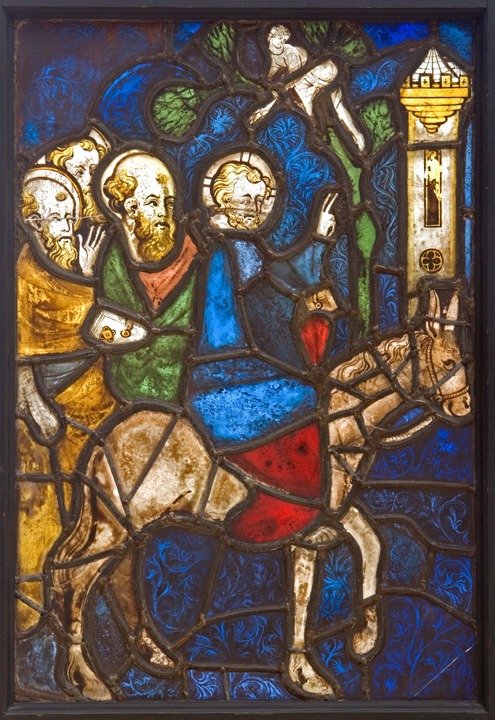
Anonymous (French), Christ’s Entry into Jerusalem, ca. 1325, stained glass (20 1/16 x 13 5/8 in.), The Hyde Collecction, Glens Falls, New York, Bequest of Charlotte Pruyn Hyde, 1971.114. Photo credit: Michael Fredericks.
In the Middle Ages, when every church was perceived as a manifestation of the Heavenly Jerusalem, the church became a representation of the early city. Galleries were built over the west door for the choir to occupy as the clergy and laity processed in as Christ had once ridden into the holy city. At Wells Cathedral, a hidden gallery was constructed within the stone façade to accommodate the choir. The boys’ voices emerged through holes in the wall behind sculptures of angels.

Detail: West facade of Well Cathedral, 1220-48, Wells, Somerset, UK. Holes behind the quatrefoils filled with sculpture allowed the sound of the cathedral choir to resonate as one entered the cathedral’s west door on Palm Sunday. Dr. Beth Harris and Dr. Steven Zucker, "Wells Cathedral," in Smarthistory, July 18, 2017, accessed April 6, 2020, https://smarthistory.org/wells-cathedral/.
This week, Holy Week, is the most important in the Christian calendar. On Maundy Thursday, the faithful will commemorate Christ’s last supper with his disciple, when He washed their feet, mourn His crucifixion on Good Friday, and celebrate His resurrection on Easter Sunday.
At the end of the Maundy Thursday service, priests in Catholic and Episcopalian churches will follow the centuries-old tradition of stripping the altars of their rich liturgical paraphernalia. They will carry away candlesticks, chalices, and crosses, and fold up richly embroidered altar cloths. Statues will be removed or covered. The church will be left bare. The sacrament will be removed from the high altar and placed in a temporary Easter Sepulcher, representing the removal of Christ’s body to Joseph of Arimathea’s tomb. I always find it striking to watch this ceremony. The congregation leaves the darkened, denuded church in silence.
It is a wonder, given the stricture against “graven idols” in the Ten Commandments, that Christian churches should have so much religious art and, indeed, such a rich cultural history of fine art, architecture, music, and the decorative arts. Once the Early Church started to accept Gentiles, particularly anyone who had grown up with the Greek and Roman pantheon of gods and statuary, it was something of a losing proposition to forbid all imagery. The fight was lost with the conversion of the Emperor Constantine in 315. He gave the Roman church silver statues of Christ and the apostles. Such cultural largesse was a standard form of imperial patronage and one the recently legalized Church was not in a position to refuse.
The Church developed several arguments for its use of and expenditure on art. Firstly, it needed to be able to perform the liturgy in a suitable building and with ritual implements. Secondly, as Pope Gregory argued in around 600, imagery helped to educate and catechize a largely illiterate congregation. The twelfth-century Abbot Suger of Saint-Denis, who in some sense was the creator of the Gothic style, wrote in his defense of the artistic riches of his abbey church that the beauty of the bejeweled liturgical vessels and the aura created by the brilliant stained glass helped to raise his thoughts from the mire and sin of this world towards the glory of heaven. In truth, he was also motivated to use art in the same manner as royalty and the aristocracy. He sought to instill awe in those who might otherwise challenge the Church’s position. It was necessary to ape the trappings of secular authority to advance and protect the Church’s own claim of independence and internationalism over and above the power of local rulers. As a divinely established institution, the glory of the Church reflected the majesty of God.

The chevet (ring of eastern chapels) at Saint-Denis, ca. 1140, Paris, France. © 2018 Richard Chenoweth.
The adoption of worldly trappings of authority is beautifully rendered in The Hyde Collection’s St. Peter Enthroned (ca. 1475-1500). Here Christ’s chosen head of the Church, the first pope is regally attired like a medieval monarch. He sits on a grand sculpted throne, swathed in a bejeweled cope of rich velvet and gold threads, wearing the papal triple tiara and holding the regalia of his office: the cross and the keys to the kingdoms of heaven and earth given to St. Peter by Christ Himself.
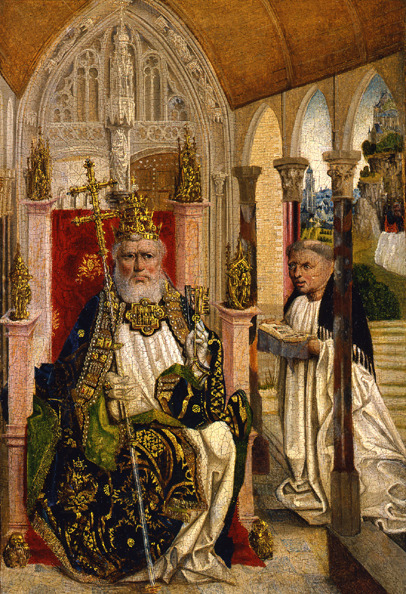
Unknown (Flemish or Portuguese, St. Peter Enthroned, ca. 1475-1500, oil on panel (12 1/4 × 8 1/2 in.) The Hyde Collection, Glens Falls, NY, Gift of Charlotte Pruyn Hyde, 1971.6.
There have been moments in the Church’s history when it has banned imagery. The Orthodox Church went through two periods of iconoclasm, the destruction of imagery, in the late eighth and early ninth centuries. Calvinists during the sixteenth-century Protestant Reformation whitewashed church interiors. English Puritans decapitated sculptures and smashed stained before boarding ships and sailing for the New World where they built their stark, unadorned meetinghouses.
The Catholic Church enthusiastically reasserted the power of religious art in the Baroque period. Shaken by the Protestant Reformation, it reclaimed its authority and rebuilt itself, constructing massive, richly adorned churches. The princes of the Church were as magnificent as any lord or princeling, the Pope as any monarch. We see redecoration of churches The Hyde Interior of a Gothic Church after Pieter Neeffs the Elder (1625-50). The side altars are dressed in altar cloths and adorned with tall winged Baroque altarpieces. At the far east end of the church, through the arch of a rood screen that divided the world of the clergy from that of the laity, one can discern a high altar, bedecked with candlesticks and a colorful altarpiece.
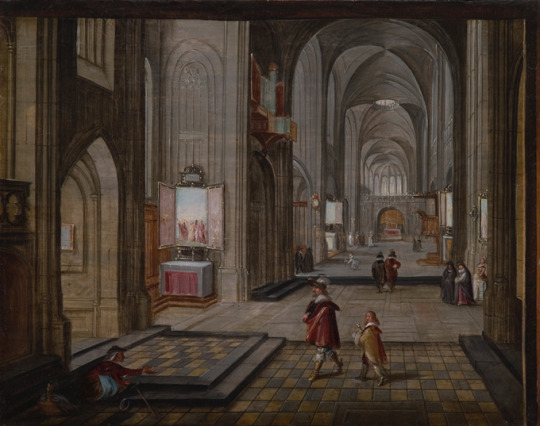
After Pieter Neeffs the Elder, (Flemish, ca. 1578 - 1659), Interior of a Gothic Church, ca. 1625 - 1650, oil on panel (13 × 11 3/4 in.) The Hyde Collection, Glens Falls, NY, Gift of Charlotte Pruyn Hyde, 1971.31.
In its day, the painting would have been viewed as a confessional declaration. Protestants in the newly independent Dutch republic possessed paintings of their whitewashed church interiors. In this painting by Pieter Saenredam ( 1597-1665), the Calvinist emphasis on the spoken word over the liturgy performed at an altar is manifested in the prominent pulpit positioned halfway down the left side of the church.

Pieter Jansz. Saenredam (Dutch 1597-1665), The Interior of St Bavo's Church, Haarlem (the 'Grote Kerk'), 1648, oil on panel (174.8 x W 143.6 cm), National Galleries of Scotland, Scottish National Gallery, NG 2413, Photo credit: National Galleries of Scotland
The Hydes were Presbyterian. Charlotte Pruyn’s family were descendants of Dutch Calvinists. I have always thought that a certain Reformist modesty regulated their lives and collecting. It did not affect the quality of their collection, rather it manifested itself in the scale and tone of what they collected. Hyde House is unique in its design but not ostentatious in scale or decoration. The Rembrandt is the largest painting the Hydes ever bought. In collecting religious imagery, they avoided large altarpieces, gruesome martyrdoms, and Baroque saints in ecstasy. Neither did they buy grand eighteenth-century portraits alluding to an Old World aristocratic heritage.
As patrons of religious architecture, they were governed by an elegant restraint. We see this in their patronage of Ralph Adam Cram (1863-1942) architect of the First Presbyterian Church (1927) in Glens Falls. Cram was the leading American Gothic Revival architect of the early twentieth century, the architect of New York’s Riverside Presbyterian Church. The Hydes’ archive contains many letters to Cram concerning design and decoration. They traveled into the Midwest and through New England to visit and review other churches, garner ideas, and assess the work of craftsmen. The restraint in the architectural decoration at First Presbyterian is reminiscent of that of the Cistercian movement, founded in response to the lavish decoration of Benedictine monasteries like Saint-Denis. St Bernard of Clairvaux (1090-1153), the founder of the Cistercian order, argued that for monks who were devoted to the study of the Bible, narrative cycles, whether painted on walls or glass, were an unnecessary and indeed dangerous distraction. Direct access to scripture negated the need for religious art.

Ralph Adam Cram (American, 1863-1942), First Presbyterian Church, 1927, Glens Falls, New York.
For the Hydes as collectors, religious art exemplified styles and movements within the history of Western art. They largely overlooked its religious function and meaning. Yet the art was never intended simply to be pretty. Its raison d’être lay in its liturgical role, what it taught, or the power it projected. I will examine these roles in further postings this Holy Week.
1 note
·
View note
Photo
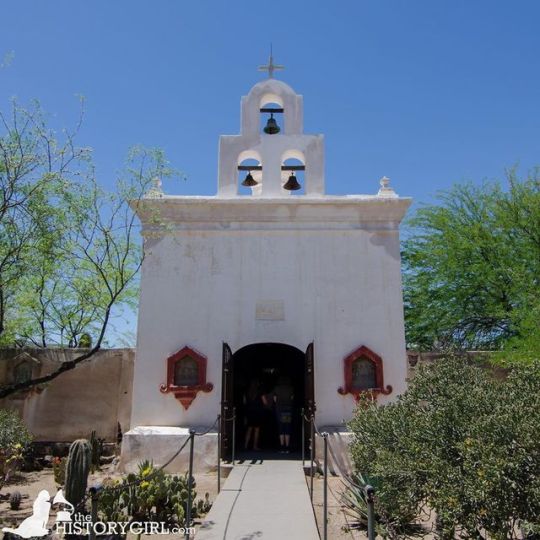
The Mortuary Chapel at Mission San Xavier del Bac in Pima County, #Arizona. The mission was named for Francis Xavier, a Christian missionary and co-founder of the Society of Jesus (Jesuit Order) in Europe. San Xavier was founded as a Catholic #mission by Father Eusebio Kino in 1692 when Southern Arizona was part of New Spain. Construction of the current church began in 1783 under #Franciscan missionary Fr. Juan Bautista Velderrain and was completed in 1797. Following Mexican independence in 1821, San Xavier became part of #Mexico. The last resident Franciscan of the nineteenth century departed in 1837. With the Gadsden Purchase of 1854, the Mission joined the United States. The Franciscans returned to the Mission in 1913. Since the early 1990s, the #church has been undergoing restoration to conserve the murals and the building envelope itself. The oldest intact European structure in Arizona, the church's interior is filled with marvelous original statuary and mural paintings. The Mission was declared a National Historic Landmark in 1960 and listed on the @nationalregisternps in 1966. In 2016, the mission was added to the @worldmonumentsfund's list of historical sites at risk from the forces of nature and human influence. This amazing mission only nine miles south of Tucson, is free to visit and tour. #az #azhistory #SpreadTheHistory #historygirl #architecture #archi_ologie #travelblog #travelblogger #blog #blogger #exploreaz #history #missionsanxavier #sanxavier #pimacounty #explore #tucsonaz #worldmonumentsfund #southernarizona #catholicchurch #nrhp #nationalhistoriclandmark #mortuarychapel #bells #chapel (at San Xavier Mission) https://www.instagram.com/p/B0M2LRWnN9X/?igshid=1v79drt7ioabm
#arizona#mission#franciscan#mexico#church#az#azhistory#spreadthehistory#historygirl#architecture#archi_ologie#travelblog#travelblogger#blog#blogger#exploreaz#history#missionsanxavier#sanxavier#pimacounty#explore#tucsonaz#worldmonumentsfund#southernarizona#catholicchurch#nrhp#nationalhistoriclandmark#mortuarychapel#bells#chapel
1 note
·
View note
Text
CALERUEGA: A site that will make you enjoy the beauty of nature and feel the presence of God.
A human without dreaming from one place to another or by means of travelling is a person that may be called a couch potato.
From a personal perspective, definitely oneself is not a couch potato.
From then until the time comes, the writer has the ambition to visit fantastic, tremendous and ecclesiastical place. Where can rejoice and have a healthy soul. Until such time as, the ambition becomes reality. How did it happen? Keep reading.
Back at the authors grade 10 level in Camiling Catholic School. Principal, Teachers and Staff established retreat in the said location. Hence, Parents and Student also agreed that it will possibly take place.
Proceeding to the next one, each class advisers collected three thousand pesos. Based on the given bill, it is consist of transportation fee, food which are the day one and two snack in the morning, lunch valid only for 2 days and dinner within a day. It also included the room for sleeping and the comfort room where bathing happens.
The days has come, retreat of student is per section. The adviser fixed plan call time. It is prohibited to be behindhand, each and every one should be like an early bird, because it is far and long time travel from Camiling Town.
Every living soul, religious or non-religious people has the habit to always pray before leaving or travelling from one place to another. So, the penman is concluded in the declared habit.
Before entering the area of Nasugbu, Batangas. The travelers can also see Taal Lake, Taal Vista Lodge, Splendido and Royal Tagaytay. Upon gain access to Nasugbu, Batangas, the pleasing view of the said site will caught the individual eyes, such as the ever crest and the views under it.
“You are here at Caleruega, Nasugbu, Batangas” Caleruega is found in Barrio Kaylaway, Batulao in the town of Nasugbu. It is just across the boundary of Cavite and Batangas. And around 15 to 20 minutes drive from Tagaytay City. As we foot inside, more Spanish treatment pleasurably satisfied the inner Architect from the lighting fixtures to the beautiful balustrade, down to the floor treatment. Outside at Caleruega there are two gates with guards on it. So it is safe. Entering inside is organized. After that, it has a two comfort room for men and women.
Foremost, that seize the visitors eye is the so called “intestine look a-like” that most aesthetic photographer took a picture on it or of it. It is located beside the cafeteria of Caleruega.
Following, as expected from a retreat center. Caleruega with its surrounding is the perfect place for relaxation and bonding with friends, family or special someone. Must and most visited spots inside these place are on the given.
First, the Transfiguration Chapel. This is the majority photographed structure and the only one that commonly see when people search “Caleruega” on google. After the first, Tent Chapel of Transfiguration. This is not to be confused with the main Transfiguration Chapel. Mortals have to walk further until these reach the farthest end of the property. Triplicity, Fountain Compass. The first to greet after oneself pass through the entrance gate. Next, Cenaculum and the Dominicum’s grand stairway. The grand staircase is a good backdrop for a photo session with companions. Then, Japanese Garden. Another beautiful spot for the nature lovers. Also the St. Dominic’s Point located near the Cenaculum and the Catalina Hall. After that, there has Hanging Bridge and Kampo Ariba. It is another good spot for capturing pictures. Visitors should past the hanging bridge to get to Tent Chapel.
In addition, there is also Manaoag Drive Via Crusis that combines nature tripping while reflecting the way of the cross, just before you reach the Koi Pond. If tourist wants a farm incase there interested worm farm will the author suggested. Try also the Garden Café consists of tasty snacks and delights at Caleruega’s in-house, café. To have souvenirs on friends, family and loved ones try visit shop of delight and plant nursery. Vendors have already plants and also self seedlings.
Caleruega also have several types of lodgings that satisfy the different needs or preferences of the guests.
About cleansing sins and restoring souls. The church is a peaceful sanctuary to meditate and pray. Sightseer do not only commune with God but also with nature. It is tiring but it is full of solemnity and serenity of the area.
It is not only for retreat activity but also for weddings. Actually, wedding and special mass are the very popular things to do on this locale.
The writer of this will give a facts. “Caleruega is actually a small town in Spain where Saint Dominic De Guzman, the founder of Dominican Order was born. Obviously, it has a Spanish Origin, but it also flourished in different parts of the world, including the Philippines.
After a satisfying interior view, next lets now head outside to savor opulent fresh air. On these generation, it almost is impossible not breathe in polluted air in the city so it really is such a relief to be here. In dealing with the people inside the Caleruega such as Sister’s, Father’s and Retreat Adviser. From each respectively, all of the said persons are kindhearted and respectful. But exception for some visitors or school that has no manners or lack of behavior, because sometimes their shrill can irritate and the place may not look like a peaceful.
Lastly, “Close to Nature, Closer to God” is one of the slogan that visitant see. Nature is about place surroundings such as trees, animals, wind and water. It is pet-friendly so visitors can bring their pets.
After the writer’s visited into this place, there are so many reflection that made the writer’s think and be more kindhearted. The reason that human often feel closer to God in nature is simple. He is the Creator. He made all that earthling see.
In the end, as a tourist it is not all about being beautiful outside such as views or site, but being beautiful inside and outside like Caleruega Nasugbu, Batangas. Exploring nature may not be a traditional spiritual discipline, but it is essential. Get out and soak it in. Let the beauty of it fill your heart and bring human bodies to worship. Reminder, do not just visit because one place because it makes you independent or freedom. Choose a place were nature reveals the glorious beauty of one who imagined it.
It may be far and tiring but all of it is worth it.
1 note
·
View note
Text
Guadalajara
After a week in CDMX, I flew to Mexico’s second city, Guadalajara. It was my first visit so setting an intention was simpler: see the sights and get to know the city. This turned out to be pretty easy since there is not a whole lot to see or do there.
On my first day I headed to the historic center which consists of four plazas surrounded by government buildings, churches and shopping arcades. The plazas were all very pleasant and well-designed. The buildings were attractive if a bit monotonous (they love Tuscan arches there). The two standouts are the beautiful Cathedral and elegant Teatro Degollado. Also notable are the Jose Clemente Orozco ceiling murals in several buildings around the city. I walked west from the center to see more churches and parks as well as the University’s art museum.
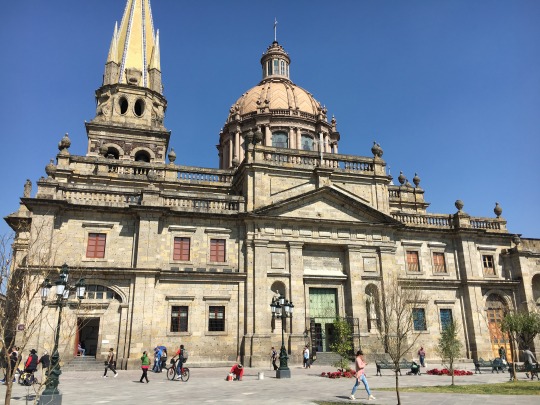
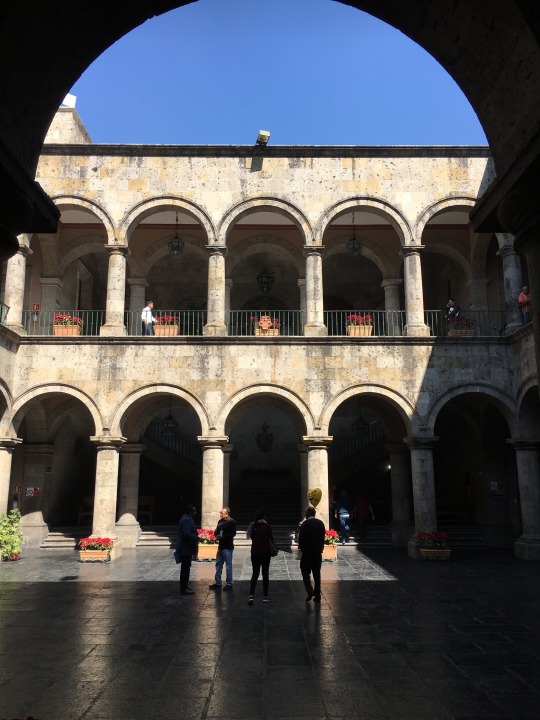

The following day I visited the nearby town of Zapopan, famed for its basilica (and the devotion of its congregation to Nuestra Senora de Zapopan, a little doll that sits above the altar). In front of the church is a lovely pedestrian walkway with some impressive public art. I also stopped at the local art museum which was refreshingly contemporary. In the afternoon I walked around Santa Tere, a traditional neighborhood that feels very authentically Mexican.
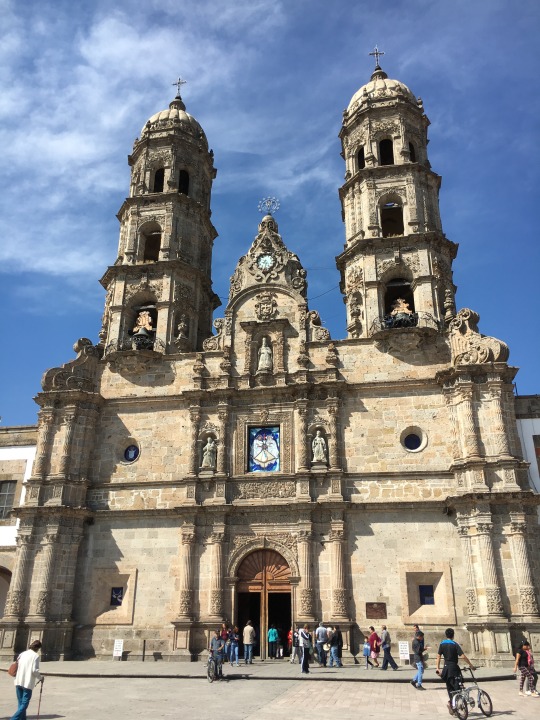
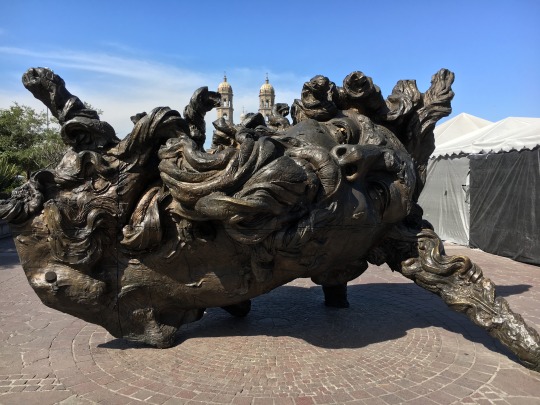

On Saturday I walked down Chapultepec, a hip area known for its restaurants, bars and clubs. It was still early however so there was not much to see. I then walked around Americana, an upscale neighborhood with some gorgeous homes, nice restaurants and hipster bars and cafes. (It reminded me of New Orleans’ Garden District.)
On Sunday I returned to the historic center, which was bustling with visitors and street performers. It was great to see all that wonderful public space so full of life. This time I walked east through the long pedestrian area of Plaza Tapatia to the stately Instituto Cultural de Cabanas. It’s a former orphanage that’s now a museum, focusing mainly on modern art. The central chapel has 57 Orozco murals, which are stunning. The numerous interior courtyards are full of whimsical sculptures, and the works in the gallery were imposing and impressive. I especially loved the temporary exhibition on the Portuguese futurist artist, Almada Negreiros. I also visited the unbelievable Mercado San Juan de Dios, a squat brutalist concrete building that houses a marketplace of nearly 30,000 vendors. You can find just about anything you could want in there (if you can actually find it).
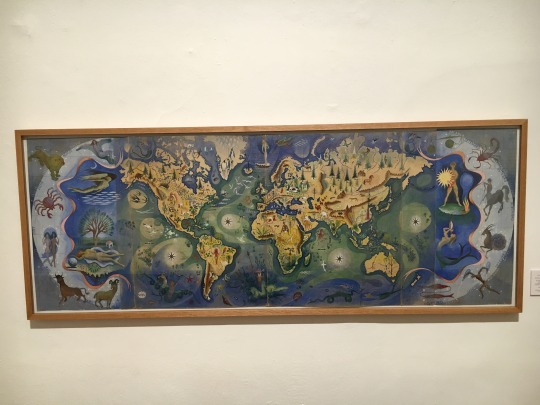


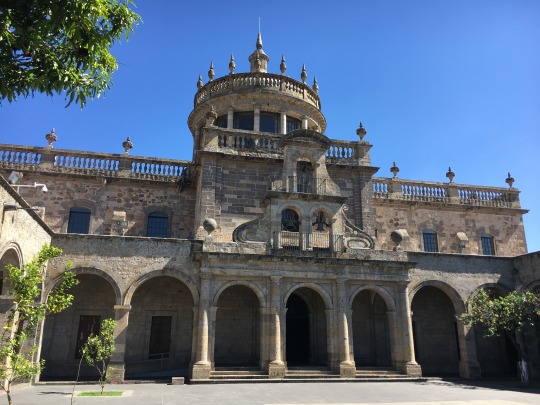
On my last day I headed out to Tlaquepaque, a nearby town that is supposedly an artist community. It’s well-preserved and full of beautiful old homes many of which now sell souvenirs, art and furniture. It’s like a Mexican Carmel or Sausalito. Still a nice place to wander around for a couple hours.
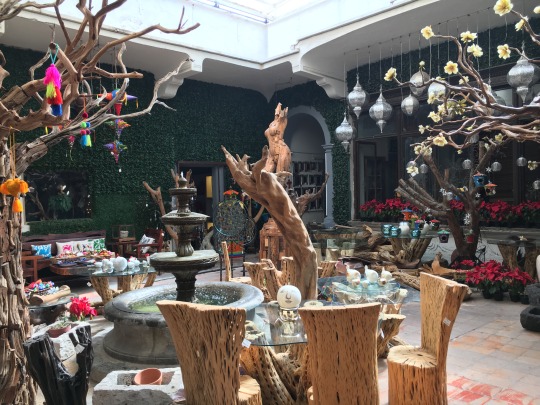

If this sounds like not much activity over a five day period, it’s because it is not. Guadalajara is lovely and has some definite highlights but three days is plenty of time there. (One popular excursion which I did not make is to visit agave farms and tequila distilleries outside of the city.) I spent a fair amount of time reading and watching Netflix, but I was OK with that. I knew I wasn’t missing anything, and it felt good to have downtime after being a busy tourist. Guadalajara also has a lot of great food as well as a strong hipster culture with all the craft beers and artisanal coffees that accompany it. Some of the local specialties, carne en su jugo (like a meat stew) and torta ahogada (fried pork on a French roll drenched in spicy sauce), did not disappoint. But I would not recommend the tejuino, a nauseatingly sweet corn drink (yes, corn).
The one last thing I will say about Guadalajara concerns the boys. I had heard that it’s a very gay city and that the guys are hotter than in CDMX. I do not know where it got that reputation. It’s a pretty conservative place with deeply ingrained Catholic guilt and ideas about machismo. Their online profiles are woefully lacking-- bad pics (or no pics), weak descriptions, even things like height left blank. They emphasize “discreto”, “varonil” (masculine) and “bi”. Most guys I talked to just wanted to see my photos. Several said they wanted to meet and then found excuses not to. And the few I did meet were not very skilled. They didn’t really participate; rather they just let sex happen to them, as if to maintain some plausible deniability.
All told, Guadalajara has some beautiful buildings, plazas, parks and art as well as some delicious food. But I don’t recommend the boys. And don’t stay too long unless you packed some good books or you’ve got some new Netflix shows to binge.
6 notes
·
View notes
Photo

Saint of the Day – 21 April – St Conrad of Parzham OFM Cap (1818-1894) – Franciscan Religious Lay Friar, Blessed Sacrament and Marian devotee, Apostle of Charity, Miracle worker with the charism of prophecy – born on 22 December 1818 at Parzham, Bavaria, Germany as Johann Birndorfer and died on 21 April 1894 in Altötting, Bavaria, Germany of natural causes. He served for over 40 years in the post of porter of the Capuchin friary in Altötting, through which work he gained a widespread reputation for his wisdom, holiness and charity. Patronages – Capuchin-Franciscan Province of Mid-America, Catholic Student Association, doorkeepers, Passau, Germany, diocese of (since 1984).

St Conrad of Parzham was born in Bavaria, Germany on 22 December 1818. He was the ninth son of a poor farming family. From his early years he gave evident signs of a deep interior life, preferring places of solitude where he could be alone with God. Despite the great distance from the nearest Church, Conrad walked frequently through rain and snow to attend the holy Mass. He had a great devotion to Our Lady and prayed the Rosary daily.

Conrad remained on the farm without much thought of the future. His mother died when he was only 14. At age 31, with the passing of his father, Conrad decided to follow his heart and become a Capuchin Franciscan. After giving away his possessions he was admitted to the novitiate as a lay brother and received the religious name Conrad (his Baptismal name was John). Immediately after his profession he was sent to the friary of St Ann, in the city of Altötting. The friary served the Shrine of Our Lady of Altötting, the National Shrine of Bavaria to the Blessed Mother.


Conrad loved silence! As mentioned, he sought places of solitude as a child in order to raise his thoughts to God. During his spare moments as a porter, he would duck into a nook near the door where it was possible to see the Blessed Sacrament in the nearby chapel. During the night, he often deprived himself of hours of sleep in order to be alone with Jesus in the chapel. It was generally believed that he never took any rest but continually occupied himself in work and exercises of devotion. Conrad also continued his childhood devotion to Our Lady, deepening his love for the Mother of God with every year of his religious life. These were his great secrets to sanctity: Silence, the Blessed Sacrament and Mary, Queen of the Friars Minor.
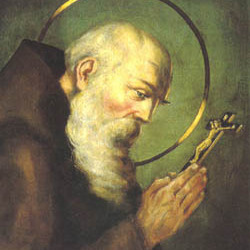
During his lifetime, Brother Conrad was reputed to have been able to read the hearts of those he met and was attributed the gift of prophecy. His heroic virtues and the miracles he performed won for him the distinction to be ranked among the Blessed by Pope Pius XI in 1930. Four years later, the same pope, approving additional miracles which had been performed, solemnly inscribed his name in the list of saints.

(via AnaStpaul – Breathing Catholic)
37 notes
·
View notes